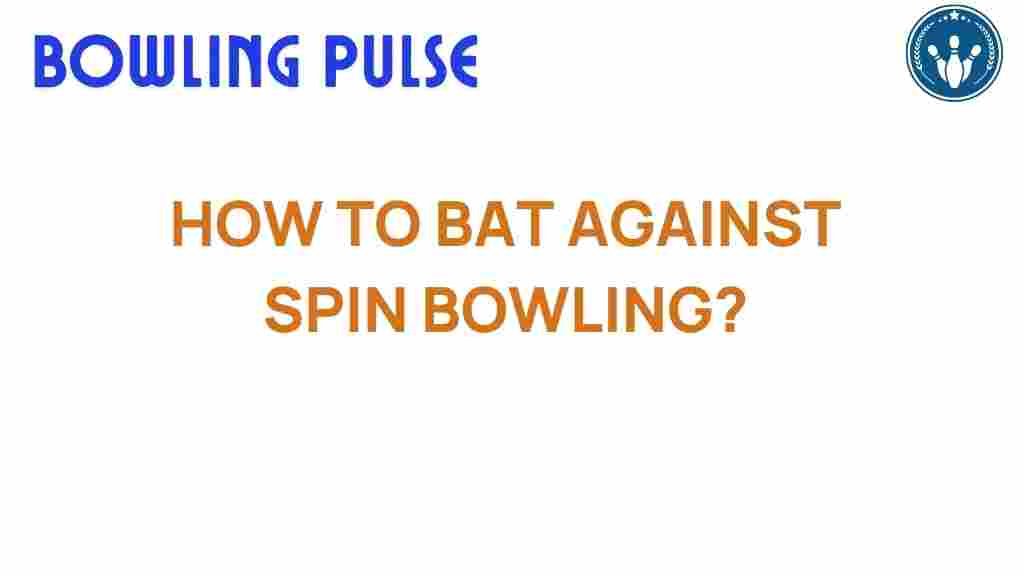Mastering Spin: Essential Techniques for Batting Success
In the dynamic world of cricket, spin bowling is a crucial aspect that can significantly impact the outcome of a match. Batting against spin requires a deep understanding of batting techniques, as well as effective sports strategy to outsmart bowlers. This article will guide you through essential techniques, drills, and strategies for mastering spin bowling, aimed at enhancing your gameplay tactics and overall player development.
Understanding Spin Bowling
Spin bowling is characterized by the bowler’s ability to impart spin to the ball, which causes it to deviate from a straight path after pitching. Understanding the types of spin bowlers—leg spinners, off-spinners, and left-arm orthodox bowlers—is fundamental for any batsman looking to excel in cricket.
- Leg Spinners: These bowlers spin the ball from leg to off, making it turn away from right-handed batsmen.
- Off Spinners: They spin the ball from off to leg, causing it to turn into right-handed batsmen.
- Left-arm Orthodox: Similar to off-spinners but bowled with a left arm, often turning the ball into right-handed batsmen.
The Importance of Batting Techniques Against Spin
To effectively counter spin bowling, a batsman must employ a variety of batting techniques. Here are some essential techniques to focus on:
- Footwork: Effective footwork is crucial. Move your feet towards the pitch of the ball to drive, or back to play the cut shot.
- Bat Angle: Adjust the bat face to control the direction of the ball. A closed face can help counteract spin.
- Balance: Maintain a low center of gravity for stability while playing your shots.
Step-by-Step Techniques to Master Spin Bowling
Here’s a step-by-step approach to enhance your batting skills against spin:
1. Assess the Bowler
Before the bowler delivers, observe their grip, run-up, and bowling style. Understanding their approach can give you an edge in anticipating the spin.
2. Position Yourself Early
Get into your batting stance and adapt based on the bowler’s length. Early positioning allows you to react better to the spin.
3. Use Your Feet
Use your feet to get to the ball. For a full delivery, step down the pitch and play a drive. For a shorter delivery, back away to cut or pull.
4. Play with a Straight Bat
When facing spin, using a straight bat ensures that you make contact with the ball effectively, reducing the chances of getting out.
5. Practice Different Shots
Incorporate a variety of shots into your training sessions, such as:
- Cut Shot
- Drive
- Sweep Shot
- Defensive Shot
Batting Drills for Spin Bowling
To develop your skills against spin bowling, consider the following batting drills:
1. Shadow Practice
Without facing a bowler, practice your footwork and shots in front of a mirror. This helps build muscle memory and improves your technique.
2. Throw Downs
Have a coach or teammate throw the ball at varying speeds and spins. Focus on adjusting your footwork and shot selection accordingly.
3. Spin Bowling Machine
Utilize a spin bowling machine to simulate different types of spin. This allows for repetitive practice and helps you become accustomed to variations in spin.
4. Game Simulation
Engage in practice matches where bowlers specifically bowl spin. This real-game scenario helps you adapt and implement your techniques under pressure.
Gameplay Tactics Against Spin
Effective gameplay tactics can make a significant difference when facing spin bowling. Here are some strategies to consider:
- Reading the Spin: Pay attention to the bowler’s hand and the seam position to gauge the type of spin they are imparting.
- Rotation of Strike: Ensure you rotate the strike regularly to keep the pressure off and avoid getting settled into a rhythm.
- Mind Games: Use tactics to unsettle the bowler. For instance, stepping down the pitch can force them to adjust their length.
Troubleshooting Common Issues in Batting Against Spin
Even seasoned players can face difficulties when batting against spin. Here are some common issues and how to address them:
1. Struggling with Footwork
If you find your footwork lacking, focus on drills that emphasize movement. Break down your footwork into smaller components to practice effectively.
2. Playing Too Late
Playing the ball late can lead to mis-hits. Work on your reaction time by increasing the pace of your training drills.
3. Getting Caught in the Air
If you frequently get caught out, focus on playing along the ground and using softer hands to absorb the impact of the ball.
4. Lack of Confidence
Confidence can wane when facing spin. Engage in mental conditioning and visualization techniques to build a positive mindset.
The Role of Cricket Coaching in Player Development
Effective cricket coaching is pivotal in developing skills against spin bowling. Coaches can provide personalized feedback, identify areas of improvement, and tailor training programs. Consider the following aspects of coaching:
- Individual Assessment: Coaches can analyze a player’s strengths and weaknesses, offering targeted drills for improvement.
- Game Strategy Development: Coaches can help players develop personalized game strategies against specific types of bowlers.
- Feedback and Adjustment: Continuous feedback allows players to adjust techniques and tactics based on performance.
For more information on effective cricket coaching strategies, check out this comprehensive guide.
Conclusion
Mastering spin bowling is an essential skill for any aspiring cricketer. By focusing on effective batting techniques, engaging in targeted batting drills, and employing smart gameplay tactics, players can significantly enhance their abilities against spin. Remember, consistent practice, along with guidance from cricket coaching, plays a vital role in your player development journey. As you refine your skills, you will not only become a more competent batsman but also a valuable asset to your team. Embrace the challenge of spin bowling, and turn it into an opportunity for growth on the cricket field.
For more insights on enhancing your cricket skills, explore our other articles on cricket strategies.
This article is in the category Techniques and created by BowlingPulse Team
